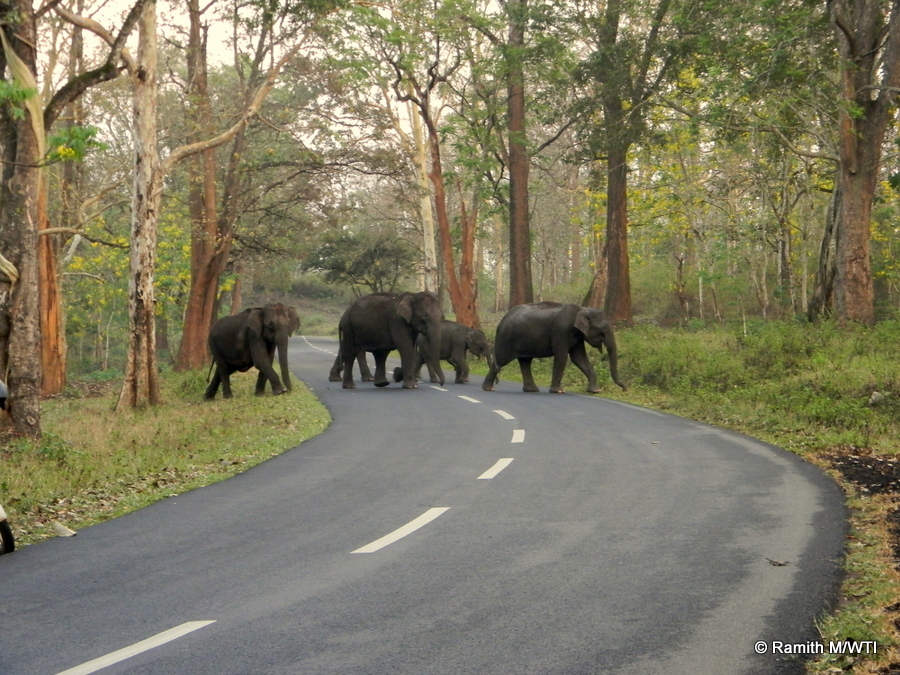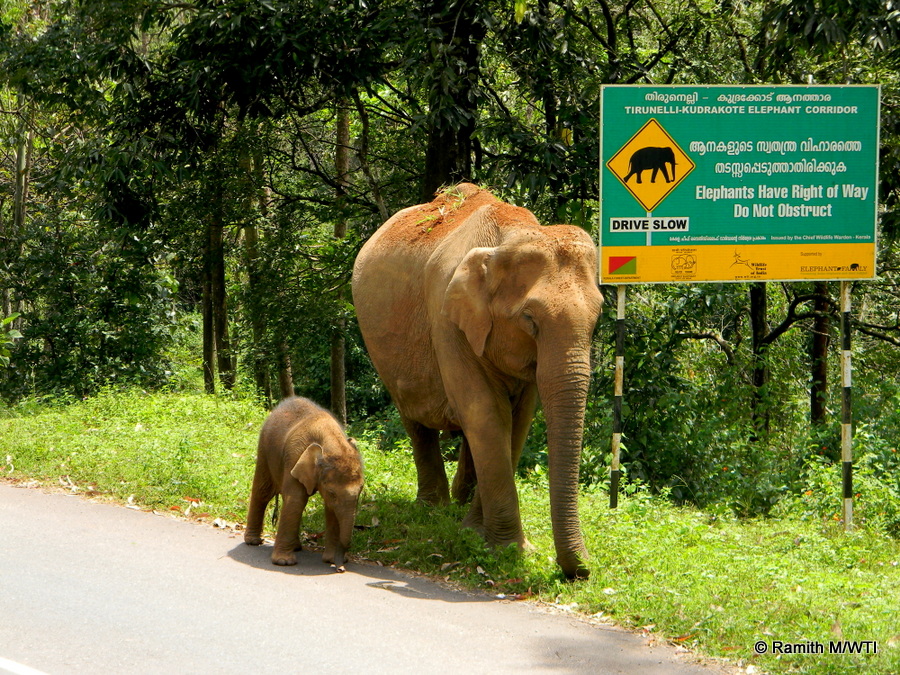Tears for the Elephant
By Vivek Menon

A herd of elephants cautiously crosses the road that leads to the Thirunelli temple, but sadly also cuts through the elephant corridor
Elephants are long-lived creatures. As an Order, Proboscideans have existed nearly 60 million years. The Asian elephant has been around at least 250,000 years. The average elephant lives 60 years, and can sometimes live up to a hundred. That’s why, I suppose, there is a lack of urgency in dealing with elephants and their problems.
Nearly two years ago I wrote a cover story for Sanctuary Asia, titled ‘Ten Ways to Save Elephants.’ I did not want to write of a hundred ways of killing elephants, which would have reflected reality, but tried positive or affirmative therapy to goad the Indian consciousness.
I guess I failed. Not just in that article but in the 30 years I have worked to conserve these gentle giants. (Not that 30 years is that much time; a mere half life of an average elephant!) What has got my goat – or elephant, for that matter – is that there are now several signs: small, insidious, tenuous at first glance, but portents of coming upheavals. If these early warnings are not heeded there could be a major tremor in the offing. I want to pay heed to these ominous omens at least on this World Elephant Day, the 12th of August 2015.
The Big Headache
Let us start ground upwards. Conflict between man and elephant is at an all-time high. Between 400 and 500 humans are killed by elephants every year in India and the famed Indian tolerance towards elephants is rapidly fraying. Retaliatory killings or shootings are on the rise. Knee jerk captures and attempts to translocate herds without understanding either elephant biology or individual herd dynamics are increasing. Political pressure is mounting to demonstrate close to zero tolerance towards elephants that ‘stray’ out of forests.
At the same time the state shows little appetite to fix the underlying mechanisms that cause elephant-human conflict.

In the Thirunelli-Kudrakote corridor of Wayanad, Kerala, a wild elephant and her young calf one stand next to a sign that says it all.
The most important of these is land. The securing of elephant corridors is paramount if these migrant beings can have a semblance of a natural geographic ramble. Both C3 and C4 habitats, i.e. woodlands and grasslands, are needed for elephants to have a sustainable diet inside forests. If only woodlands are present, elephants seek out crops like paddy. A proliferation of easily available crops surrounding forest areas, and an unscientific expansion of water bodies both inside and outside the forest, is causing an overabundance of elephants. Tackling all this requires meticulous and long-term planning.
Meanwhile, the spectre of poaching – which was under control through the late 90s and the first decade of this century – has reared its head again. Odisha has been targeted repeatedly and the graph is now moving upwards in Kerala. These are not healthy signs. Early enough to be arrested, but disturbing nonetheless.
Captive elephant care is also deteriorating in major centres, so much so that British MPs recently petitioned the Indian government to do more to stop cruel practices. Surely this is something we should have seen and acted upon within the country, without foreign bidding!
Finally, the budget of Project Elephant has been cut to a miniscule 16 crore for the whole country. Compare this with 161 crore for the National Tiger Conservation Authority (and I must make it clear here that I do not grudge the tiger its due) and you can see why I am being pessimistic. The elephant has a range that is one-and-a-half times larger than that of the tiger in India. There are nearly 15 times as many elephants as there are tigers in India. Elephants kill more than 5-6 times the number of humans than tigers do and conflict mitigation is therefore so much more urgent. And the National Heritage Animal is assigned one-tenth the central budget of the tiger? Begs a question does it not? And a furrowed brow!
The People Who Do
What can be done in the face of these issues? I know what we at the Wildlife Trust of India are doing. We have prioritised the securing of corridors as the long-term way out of this mess. We have mapped these corridors and with the government and a group of NGOs called the Elephant Alliance, are working to secure them one at a time.
Our on ground anti-poaching training is concentrated in areas where the issues are most pressing; more than 10,000 frontline staffers have been trained. A major rehabilitation program in Assam over the last ten years (in Manas National Park) has shown that young orphaned elephants can return to the wild instead of feeding an overburdened captive industry. We are championing low cost and high speed conflict resolution tactics in many parts of the country. We have shown how, in Rajaji National Park, train hits can be stopped if a concentrated project is undertaken – and then applied these methods in Kerala, Tamil Nadu and Odisha with similar results. At the policy level I have personally attended CITES meetings for 25 years and lobbied to ensure that the international ivory trade either does not get sanctioned, or if it does, has minimum impact on India.
There is much that can be done and much that people are doing. There are a multitude of examples, such as the electronic eye of the Nature Conservation Foundation (NCF) in the Valparai plateau, and their work in Bandipur; the long term research of the Asian Nature Conservation Foundation (ACNF) in the Nilgiris; the work of Aaranyak in Assam, or the Wildlife Society of Odisha, or of Compassion Unlimited Plus Action (CUPA) on captive elephant welfare. There is hope because of these varied organisations and wonderful individuals who are dedicating their lives to the service of elephants and their ecosystems.
Can we not upscale these wonderful efforts to match the range of our once friendly giants? Can the government not respond with a budget and framework that allows Project Elephant the prominence it deserves? Can we not, on Elephant Day, remember Haathi Mere Saathi or Lord Ganesha or the majestic yaanai in the way it merits, rather than as our biggest headache among wild species? Can we not invoke an ancient image:
And adorned with floral pollen accompanied by buzzing bees,
Drugged with the fragrance of rut and shaking big trees along the way
The breeze sped down around the hermitage”
~ Kannasa Ramayanam, Balakandam, 220
The author is a conservationist, writer, photographer and Executive Director of the Wildlife Trust of India. This article was first published in Sanctuary Asia, August, 2015.









